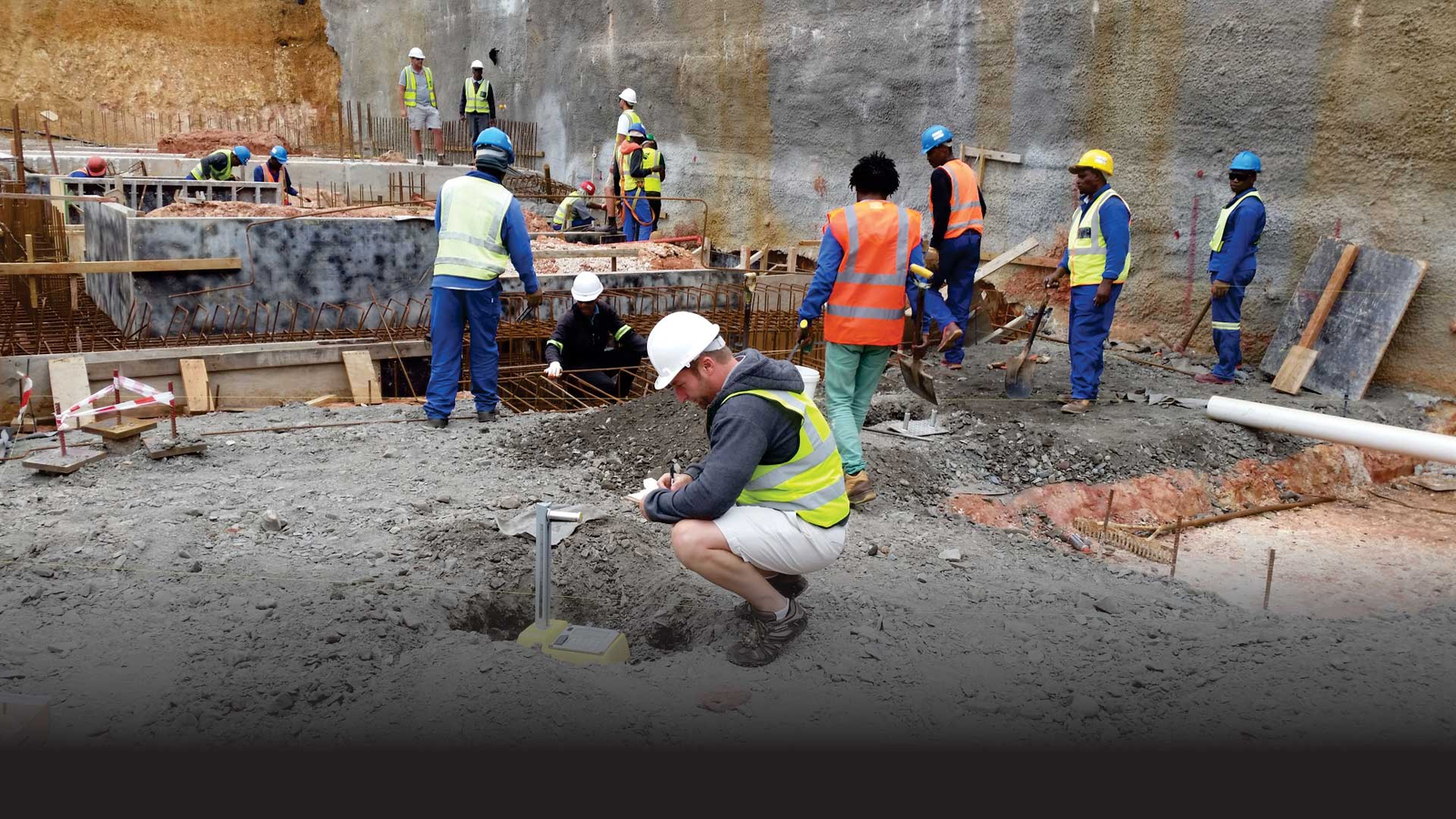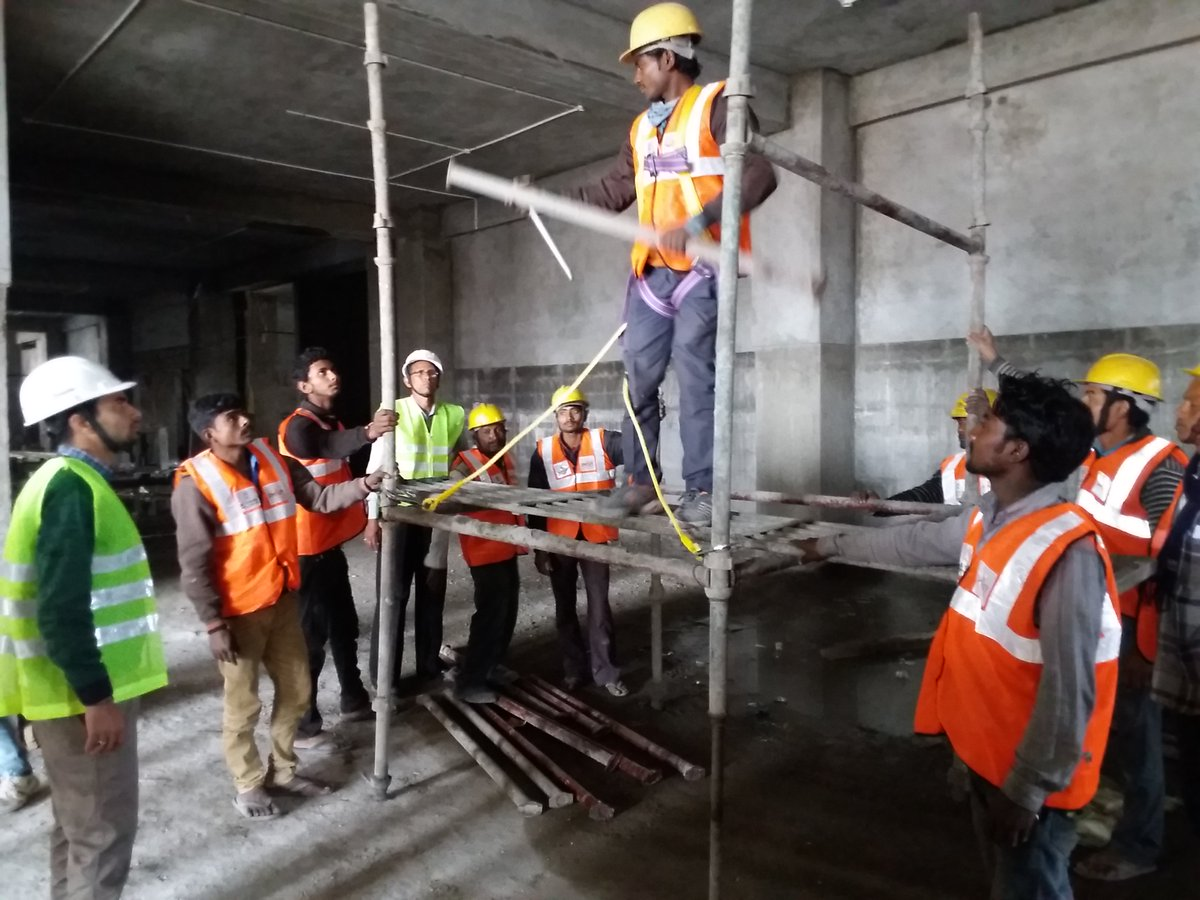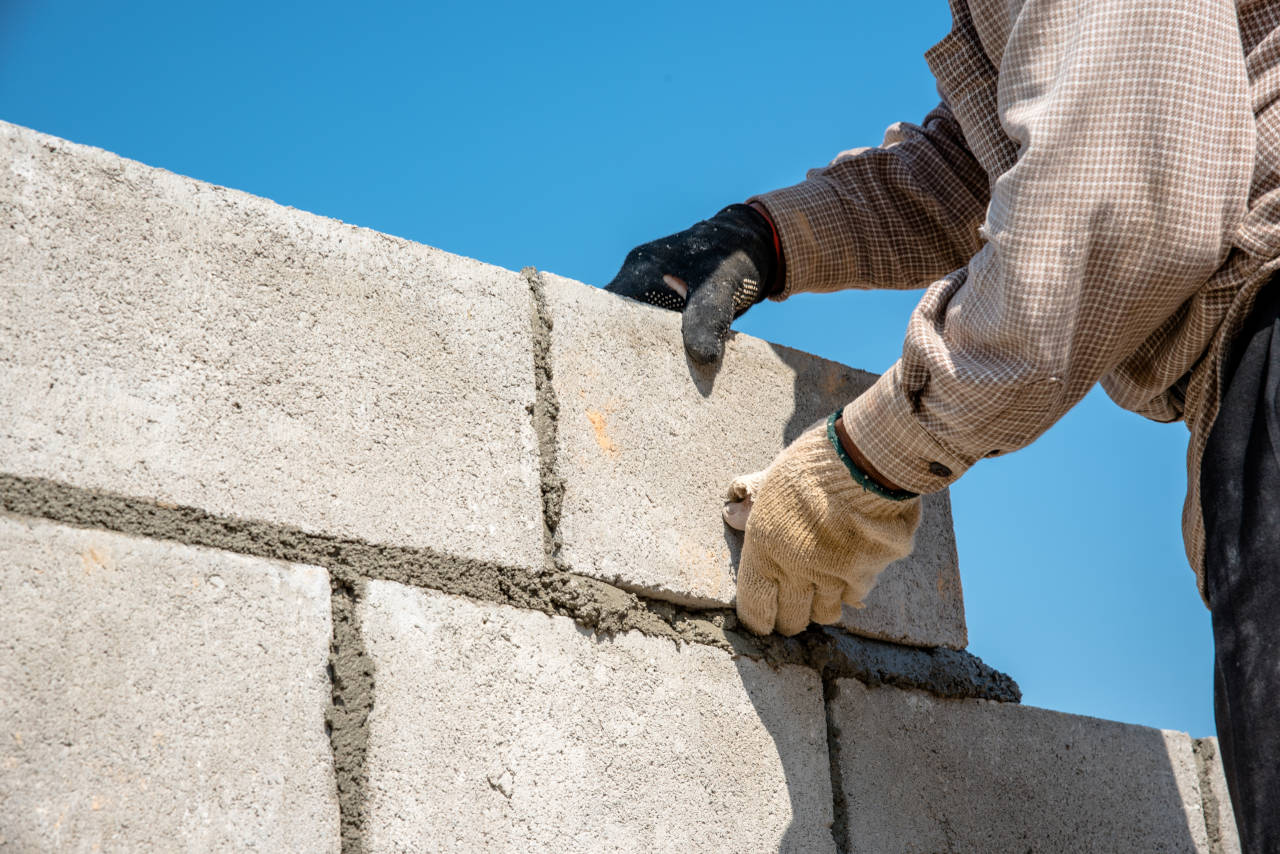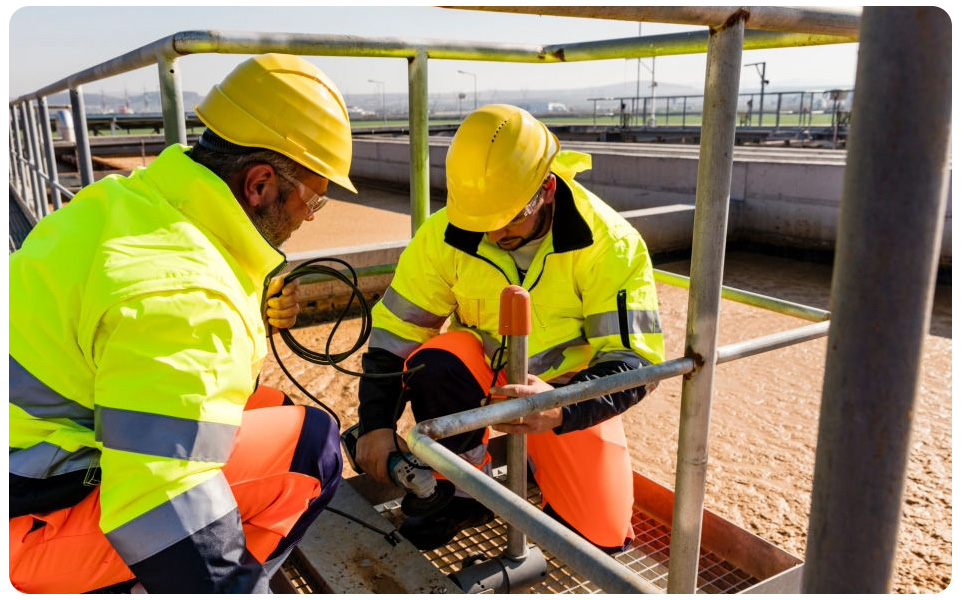Helper – Construction Laboratory and Field Technician ( 6 month course)
Helper – Construction Laboratory and Field Technician click here
Brief Job Description
This job role is responsible for the identification of testing tools and equipment, handling and storing of
test samples, extracting sample from fields, safe shifting of samples to the laboratory, sample preparation,
and providing support in the testing of construction materials including cement, sand, aggregate, bitumen, concrete, bricks, and concrete blocks.

Personal Attributes
The helper laboratory and field technician is expected to be physically fit and should be able to work
across various locations in extreme weather/site conditions. The individual should be team-oriented.
Identify and upkeep construction materials ,testing tools and equipment
Description
This unit describes the skills and knowledge required to identify and upkeep the construction materials,
testing tools, and equipment required for quality testing as per instructions and under close supervision.
Scope
The scope covers the following :
Perform identification and upkeep of construction materials, testing tools and equipment
Elements and Performance Criteria

Perform identification and upkeep of construction materials, testing tools and equipment
To be competent, the user/individual on the job must be able to:
PC1. identify construction materials such as cement, fine and coarse aggregate, bricks, steel,
bitumen, admixtures, concrete blocks, paver block, timber, plywood & steel reinforcement bar
etc.
PC2. identify testing tools and accessories such as measuring jar, gauging trowel, measurement
tape, metal scale, scoop, tray, tamping rod, stop watch, brushes, funnel, thermometer, Vernier
calipers, IS sieves of different size, trowel, spade, pickaxe, vibrator etc.
PC3. identify apparatus and equipment required for cement and concrete testing such as Vicat
apparatus & accessories, GI Sieves, Digital weighing balance drying oven and cube moulds,
compression testing machine, flow table, laboratory concrete mixer, slump test cone etc.
PC4. identify apparatus and instruments required for soil testing such as hydrometer, standard
sieves of different size, compaction test apparatus, rapid moisture content meter, CBR testing
machine, liquid & plasticity limit test apparatus
PC5. identify apparatus and instruments required for aggregate testing such as flakiness gauge,
elongation gauge, ring and ball apparatus, pycnometer, impact value test apparatus, crushing
value test apparatus & Los Angeles abrasion test apparatus
PC6. identify apparatus and instruments required for bitumen testing such as penetrometer,
bitumen compactor, Marshall stability test apparatus
PC7. identify apparatus ,instruments, chemicals required for water testing
PC8. clean, inspect and care for the construction materials, testing tools and equipment used for
quality testing.
Knowledge and Understanding (KU)
The individual on the job needs to know and understand:
KU1. safety rules and regulations for handling and storing relevant tools, equipment, and
materials for relevant works in accordance with organizational norms
KU2. importance of personal protection including the use of related safety gears & equipment in
accordance with organizational norms
KU3. service request procedures for tools, materials, and equipment as per organizational norms
KU4. procedure for maintenance of tools and equipment
KU5. different type of construction materials and their testing
KU6. storing and handling of construction materials
KU7. name of tools and equipment used for testing construction material such as cement, fine and
coarse aggregate, bricks, steel, bitumen, admixtures, concrete blocks, paver block, concrete
cubes, timber, plywood & steel, reinforcement bar
KU8. upkeep of tools and equipment
KU9. the nomenclature of various parts of the equipment
KU10. prevention techniques of equipment from dust and heat
Generic Skills (GS)
User/individual on the job needs to know how to:
GS1. write in one or more language, preferably in the local language of the site
GS2. read instructions provided for the work, and various signboards, safety rules, safety tags, exit
route information in one or more languages, preferably in the local language of the site

GS3. speak in one or more language, preferably in one of the local languages of the site
GS4. communicate orally and effectively with team members
GS5. analyze the safety aspect of the workplace
GS6. plan self-work to achieve productivity as per the direction /close supervision of superiors
GS7. ensure work is done within time and as per desired quality based on instructions provided by superiors
GS8. identify any violation of safety norms during the work
Handle and store construction material test sample at the laboratory
Description
This unit describes the skills and knowledge required for effective material handling & storing of test
samples in the lab as per instructions under close supervision.
Scope
The scope covers the following :
Handle and store construction material for testing at the laboratory
Elements and Performance Criteria
Handle and store construction material for testing at the laboratory
To be competent, the user/individual on the job must be able to:
PC1. follow instructed methods/set guidelines for collection and handling of material samples such
as cement, steel, sand, aggregate, soil, admixtures, brick, concrete blocks and distilled water
PC2. store and stack inflammable material separately as per standard practices/instructions
PC3. handle loose and fluid materials like chemicals, form-oil & admixtures as per standard
practices/ instructions
PC4. follow specified procedure for sampling, packing and tagging of materials for testing
PC5. follow specific procedure for storing and stacking of material samples
Knowledge and Understanding (KU)
The individual on the job needs to know and understand:
KU1. safety rules and regulations for handling and storing relevant tools, equipment, and materials
for relevant works in accordance with organizational norms
KU2. importance of personal protection including the use of related safety gears & equipment in
accordance with organizational norms
KU3. service request procedures for tools, materials and equipment as per organizational norms
KU4. procedure for maintenance of tools and equipment
KU5. use of tools and equipment for testing of construction material
KU6. handling and stacking of tools, equipment, hazardous materials, and chemicals
KU7. storing, handling and labeling of construction material samples such as soil, aggregates,
concrete, bricks, steel, bitumen, admixtures, timber, plywood & steel reinforcement bar
Generic Skills (GS)
User/individual on the job needs to know how to:
GS1. write in one or more language, preferably in the local language of the site
GS2. read various, sign boards, safety rules , safety tags and instructions related to exit routes
during emergency at the workplace
GS3. speak in one or more language, preferably in one of the local languages of the site
GS4. communicate orally and effectively with team members
GS5. analyze the safety aspect of the workplace
GS6. plan work to achieve productivity as per the direction /close supervision of superiors
GS7. ensure work is done within time and as per desired quality based on instructions provided by
superiors
GS8. evaluate the complexity of the tasks
GS9. identify any violation of safety norms during the work
Collect test sample from field and assist in material testing at site laboratory
Description
This unit describes the skills and knowledge required to collect, prepare test samples, and support in
construction materials testing at site and in site laboratory as per instructions and under close supervision.
Scope
The scope covers the following :
Collect/extract soil, concrete, and bitumen samples from the field.
Prepare test samples, tools, and test apparatus for cement, concrete, bricks, and aggregates testing
and provide support in testing

Prepare test samples, tools, and test apparatus for bitumen testing and provide support in testing.
Prepare test samples, tools, and test apparatus for soil testing and provide support in testing.
Perform housekeeping and dispose waste.
Elements and Performance Criteria
Collect/extract soil , concrete and bitumen samples from field
To be competent, the user/individual on the job must be able to:
PC1. extract soil samples using core cutters , pack & label the sample as per standard procedure
and transport it to test laboratory
PC2. collect hot bitumen sample from construction site as per instructions, pack & label the
sample as per standard procedure and transport it to test laboratory
PC3. collect and cast concrete cube samples at site as per standard procedure and instructions
Prepare test samples, tools, and test apparatus for cement, concrete, bricks, and aggregates testing and
provide support in testing
To be competent, the user/individual on the job must be able to:
PC4. prepare all tools and accessories required for cement, concrete, brick and aggregate testing
for sample preparation and testing as per instructions
PC5. collect the required/ instructed quantity of sample of cement, concrete, brick and aggregate
as per instructions
PC6. measure instructed quantity of sample to be tested in the site laboratory
PC7. cast cement and concrete cube samples in site laboratory as per standard procedure and
instructions
PC8. prepare cement test samples and provide support in slump test, consistency test ,initial &
final setting time test, fineness test and soundness test as per instructions
PC9. carry out sieve analysis and prepare test samples for specific gravity, crushing value, impact
value test, abrasion value for coarse aggregate as per instructions
PC10. provide support in carrying out water absorption test and compressive strength test of
cement cube, concrete cube, brick, concrete block & paver block
Prepare test samples, tools, and test apparatus for bitumen testing and provide support in testing
To be competent, the user/individual on the job must be able to:
PC11. prepare all required tools and accessories of bitumen testing for sample preparation and
testing as per instructions
PC12. collect the required/ instructed quantity of sample of bitumen as per instructions
PC13. measure instructed quantity of bitumen sample to be tested in site laboratory
PC14. prepare bitumen test sample and provide support in content test, penetration test, specific
gravity test, softening point test, flash & fire point, Marshall stability test of bitumen mixture
as per instructions

Prepare test samples, tools, and test apparatus for soil testing and provide support in testing.
To be competent, the user/individual on the job must be able to:
PC15. prepare all required tools and accessories of soil testing for sample preparation and testing
as per instructions
PC16. collect the required/ instructed quantity of sample of soil as per instructions
PC17. measure instructed quantity of sample to be tested in site laboratory
PC18. prepare soil test samples and provide support in test for specific gravity, bulk density,
moisture content, Atterberg limits, and silt content of soil as per instructions
Perform housekeeping and dispose waste
To be competent, the user/individual on the job must be able to:
PC19. clean tools, apparatus, instrument, and accessories and place them at the appropriate
location after use
PC20. upkeep all tools, apparatus, instrument, and equipment as per requirement
PC21. dispose the tested construction materials as per instructions
Knowledge and Understanding (KU)
The individual on the job needs to know and understand:
KU1. safety rules and regulations for handling and storing relevant tools, equipment, and
materials for relevant works in accordance with organizational norms
KU2. importance of personal protection including the use of related safety gears & equipment in
accordance with organizational norms
KU3. service request procedures for tools, materials and equipment as per organizational norms
KU4. storing and handling of construction material samples
KU5. how to prepare test sample for cements, concrete, sand, aggregate, bitumen, soil
KU6. how to carry out sampling of concrete, soil, sand in site
KU7. visual/physical checking of cement, brick ,concrete block, sand
KU8. importance of checking construction material prior to use
KU9. use of tools and equipment for testing of construction material
KU10. handling technique of tools and equipment
KU11. upkeep, repair, and maintenance of tools and equipment
KU12. prevention of equipment from dust and heat
KU13. the calibration of machines and equipment for validation
KU14. reading of gauges and meters along with the least count
KU15. disposal of tested material in appropriate manner
Generic Skills (GS)
User/individual on the job needs to know how to:
GS1. write in one or more language, preferably in the local language of the site
GS2. read various, sign boards, safety rules , safety tags and instructions related to exit routes
during emergency at the workplace
GS3. speak in one or more language, preferably in one of the local languages of the site
GS4. communicate orally and effectively with team members
GS5. analyze the safety aspect of the workplace
GS6. plan work to achieve productivity as per the direction /close supervision of superiors
GS7. ensure work is done within time and as per desired quality based on instructions provided by superiors
GS8. identify any violation of safety norms during the work
Work effectively in a team to deliver desired results at the workplace
Description
This unit describes the skills and knowledge required to work effectively within a team to achieve the
desired results
Scope
The scope covers the following :
Interact and communicate effectively with co-workers, superiors and sub-ordinates across different
teams
Support co-workers, superiors and sub-ordinates within the team and across interfacing teams to
ensure effective execution of assigned task
Acknowledge and show sensitivity to disability, culture and gender diversity
Elements and Performance Criteria
Interact and communicate effectively with co-workers, superiors and sub-ordinates across different teams
To be competent, the user/individual on the job must be able to:
PC1. pass on work related information/ requirement clearly to the team members
PC2. inform co-workers and superiors about any kind of deviations from work
PC3. address the problems effectively and report if required to immediate supervisor
appropriately
PC4. receive instructions clearly from superiors and respond effectively on the same
PC5. communicate to team members/subordinates for appropriate work technique and method
PC6. seek clarification and advice as per the requirement and applicability
• Support co-workers, superiors and sub-ordinates within the team and across interfacing teams to
ensure effective execution of assigned task
To be competent, the user/individual on the job must be able to:
PC7. hand over the required material, tools tackles, equipment and work fronts timely to
interfacing teams
PC8. work together with co-workers in a synchronized manner
Acknowledge and show sensitivity to disability, culture and gender diversity
To be competent, the user/individual on the job must be able to:
PC9. follow practices which are sensitive to disability, culture and gender diversity.

PC10. respond to attitude and behavior which are aggressive, abusive or discriminatory, in a
professional manner and as per organizational policy
Knowledge and Understanding (KU)
The individual on the job needs to know and understand:
KU1. own roles and responsibilities
KU2. importance of effective communication and establishing strong working
KU3. risks of a failure in teamwork in terms of effects on project outcomes, timelines, safety at the
construction site, etc.
KU4. different modes of communication, and its appropriate usage
KU5. importance of creating healthy and cooperative work environment among the gangs of
workers
KU6. different activities within his work area where an interaction with other workers is required
KU7. applicable techniques of work, properties of materials used, tools and tackles used, safety
standards that co- workers might need as per the requirement
KU8. importance of proper and effective communication and the expected adverse effects in case
of failure relating to quality, timelines, safety, risks at the construction project site
KU9. importance and need of supporting co-workers facing problems for smooth functioning of
work
KU10. the fundamental concept of gender equality
KU11. how to recognize and be sensitive to issues of disability, culture and gender
Generic Skills (GS)
User/individual on the job needs to know how to:
GS1. write in at least one language, preferably in the local language of the site
GS2. read in one or more languages, preferably the local language of the site
GS3. read communication from team members regarding work completed, materials used, tools
and tackles used, support required
GS4. speak in one or more languages, preferably in one of the local language of the site
GS5. listen and follow instructions / communication shared by superiors/ co-workers regarding
team requirements or interfaces during work processes
GS6. communicate orally with co-workers regarding support required to complete the respective
work
GS7. decide on what information is to be shared with co-workers within the team or from
interfacing gang of workers
GS8. plan work and organize required resources in coordination with team members
GS9. complete all assigned task in coordination with team members
GS10. take initiative in resolving issues among co-workers or report the same to superiors
GS11. ensure best ways of coordination among team members
GS12. communicate with co-workers considering their educational / social background
GS13. evaluate the complexity of task and determine if any guidance is required from superiors
Work according to personal health, safety and environment protocols at construction site
Description
This NOS covers the skill and knowledge required for an individual to work according to personal health,
safety and environmental protocol at construction site
Scope
The scope covers the following :
Follow safety norms as defined by organization
Adopt healthy & safe work practices
Implement good housekeeping and environment protection process and activities
Follow infection control guidelines as per applicability
Elements and Performance Criteria
Follow safety norms as defined by organization
To be competent, the user/individual on the job must be able to:
PC1. identify and report any hazards, risks or breaches in site safety to the appropriate authority
PC2. follow emergency and evacuation procedures in case of accidents, fires, natural calamities
PC3. follow recommended safe practices in handling construction materials, including chemical
and hazardous material whenever applicable
PC4. follow all the protocols and safety techniques conveyed during safety awareness programs
like Tool Box Talks, safety demonstrations and mock drills conducted at the site
PC5. • select and operate different types of fire extinguishers corresponding to various types of fires
• as per EHS guideline
PC6. identify near miss , unsafe condition and unsafe act
Adopt healthy & safe work practices
To be competent, the user/individual on the job must be able to:
PC7. use appropriate Personal Protective Equipment (PPE) as per work requirements including:
Head Protection (Helmets) Ear protection Fall Protection Foot Protection Face and Eye
Protection, Hand and Body Protection Respiratory Protection (if required)
PC8. handle all required tools, tackles , materials & equipment safely
PC9. follow safe disposal of waste, harmful and hazardous materials as per EHS guidelines
PC10. check and install all safety equipment as per standard guidelines
PC11. follow safety protocol and practices as laid down by site EHS department
PC12. obtain “height pass” clearance for working at heights
Implement good housekeeping practices
To be competent, the user/individual on the job must be able to:
PC13. • collect, segregate and deposit construction waste into appropriate containers based on their
• toxicity or hazardous nature
PC14. apply ergonomic principles wherever required
Follow infection control guidelines as per applicability
To be competent, the user/individual on the job must be able to:
PC15. follow recommended personal hygiene, workplace hygiene and sanitization practices
PC16. clean and disinfect all materials, tools and supplies before and after use
PC17. • report immediately to concerned authorities regarding signs and symptoms of illness of self
• and others
Knowledge and Understanding (KU)
The individual on the job needs to know and understand:
KU1. reporting procedures in cases of breaches or hazards for site safety, accidents, and
emergency situations as per guidelines
KU2. types of safety hazards at construction sites
KU3. basic ergonomic principles as per applicability
KU4. the procedure for responding to accidents and other emergencies at site
KU5. use of appropriate personal protective equipment based on various working conditions
KU6. importance of handling tools, equipment, and materials as per applicable norms
KU7. effect of construction material on health and environments as per applicability
KU8. various environmental protection methods as per applicability
KU9. storage of waste including non-combustible scrap material and debris, combustible scrap
material and debris, general construction waste and trash (non-toxic, non-hazardous), any
other hazardous wastes and any other flammable wastes at the appropriate location
KU10. how to keep the workplace neat and tidy so as to be safe
KU11. how to use hazardous material in a safe and appropriate manner as per applicability
KU12. types of fire
KU13. procedure of operating different types of fire extinguishers
KU14. safety relevant to tools, tackles, and equipment as per applicability
KU15. housekeeping activities relevant to task
KU16. ways of transmission of infection
KU17. ways to manage infectious risks at the workplace
KU18. different methods of cleaning, disinfection, sterilization, and sanitization
KU19. symptoms of infection like fever, cough, redness, swelling, and inflammation
Generic Skills (GS)
User/individual on the job needs to know how to:
GS1. write in at least one language, preferably in the local language of the site
GS2. fill safety formats for near miss, unsafe conditions and safety suggestions
GS3. read in one or more language, preferably in the local language of the site
GS4. speak in one or more language, preferably in one of the local language of the site
GS5. listen to instructions/communication shared by site EHS and superiors regarding site safety,
and conducting the toolbox talk
GS6. identify potential safety risks and report to the appropriate authority
GS7. • assess and analyze areas which may affect health, safety and environment protocol on the
• site








